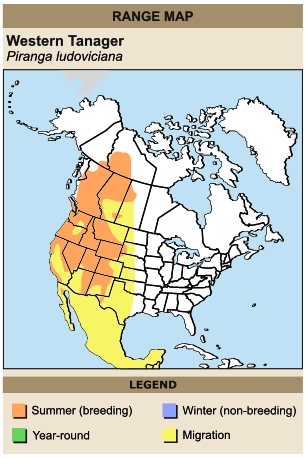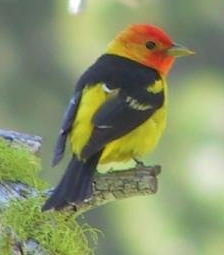
Medium-sized tanager with brilliant red head, bright yellow body, black
back, wings, and tail. Wings have two bars: upper bar is yellow, lower
bar is white. Legs and feet are gray.
Swift direct flight on rapidly beating wings. It was first recorded
on
the Lewis and Clark expedition.

|
WESTERN
TANAGER
Piranga ludoviciana
PASSERIFORMES
Tanagers (Thraupidae)
Range
and Habitat
Breeds from southern Alaska and Mackenzie southward
and winters in the tropics. Preferred habitats include open coniferous
forests.
SOUND:
"che-ree, che-ree, che-weeu, cheweeu", "pit-r-rick"
The Western Tanager breeds farther north than any other member of its
mostly tropical family, breeding to
nearly 60° N in the Northwest Territories.
The red pigment in the face is not produced by the bird
but is acquired through their diet of insects that themselves acquire
it from plants.
This species was first recorded on the Lewis and Clark expedition(1803-1806).

A group of tanagers
are collectively known as a
"season" of tanagers.
The Western Tanager is a medium songbird native to the Americas, and
is considered a relative to cardinals. Preferred breeding habitats include
coniferous and mixed woodlands
found in western North America, including the Mexico-U.S. border and
southern Alaska. Nests are cup-shaped and built
in a conifer’s horizontal branch.
During winter months, this species will migrate to central Mexico, Costa
Rica and southern California. Food is gathered high in the trees of
the forest, and insects are sometimes caught mid-flight. Diets consist
of fruits, berries and insects.
|




